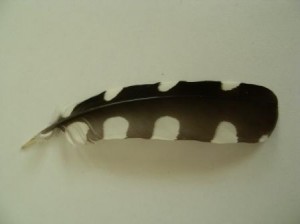A feathery find
Most feathers are difficult to I.D. because they all look very similar and there are detailed books to help you tell the difference.
So I was delighted when I found this one. With its black colour and clear white spots it could only belong to a great spotted woodpecker.

This one is a flight feather. Flight feathers are divided in to two categories: those from the wing (remiges) and those from the tail (rectrices). In woodpeckers the tail feathers are very stiff because they use them to brace themselves against trees. As this one is a bit softer it’s most likely from the wing. Being spotty it’s also one of the feathers that give the great spotted woodpecker its name.
Towards the end of summer, birds begin to moult, so this feather might be from a woodpecker that is getting a head start in the process. Moulting just means their old feathers are replaced by new. There are problems with this though, as whilst they lose flight feathers they may also lose the ability to fly.
At this time, birds go in to hiding and it can seem like all the birds in your garden have disappeared. But don’t worry, they will return soon with their shiny new feathers, looking more beautiful than ever.
Bye for now,
Rhian (Seasonal Ranger)
Help protect Scotland’s wildlife
Our work to save Scotland’s wildlife is made possible thanks to the generosity of our members and supporters.
Join today from just £3 a month to help protect the species you love.
Preface
Most feathers are difficult to I.D. because they all look very similar and there are detailed books to help you tell the difference. So I was delighted when I found …
